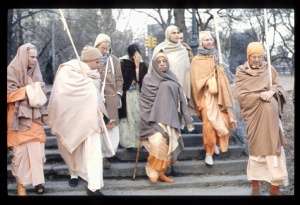CC Madhya 19.180 (1975): Difference between revisions
(Vanibot #0027: CCMirror - Mirror CC's 1996 edition to form a basis for 1975) |
(Vanibot #0020: VersionCompareLinker - added a link to the Version Compare feature) |
||
| Line 2: | Line 2: | ||
<div style="float:left">'''[[Sri Caitanya-caritamrta (1975)|Śrī Caitanya-caritāmṛta (1975)]] - [[CC Madhya (1975)|Madhya-līlā]] - [[CC Madhya 19 (1975)|Chapter 19: Lord Śrī Caitanya Mahāprabhu Instructs Śrīla Rūpa Gosvāmī]]'''</div> | <div style="float:left">'''[[Sri Caitanya-caritamrta (1975)|Śrī Caitanya-caritāmṛta (1975)]] - [[CC Madhya (1975)|Madhya-līlā]] - [[CC Madhya 19 (1975)|Chapter 19: Lord Śrī Caitanya Mahāprabhu Instructs Śrīla Rūpa Gosvāmī]]'''</div> | ||
<div style="float:right">[[File:Go-previous.png|link=CC Madhya 19.179 (1975)|Madhya-līlā 19.179]] '''[[CC Madhya 19.179 (1975)|Madhya-līlā 19.179]] - [[CC Madhya 19.181 (1975)|Madhya-līlā 19.181]]''' [[File:Go-next.png|link=CC Madhya 19.181 (1975)|Madhya-līlā 19.181]]</div> | <div style="float:right">[[File:Go-previous.png|link=CC Madhya 19.179 (1975)|Madhya-līlā 19.179]] '''[[CC Madhya 19.179 (1975)|Madhya-līlā 19.179]] - [[CC Madhya 19.181 (1975)|Madhya-līlā 19.181]]''' [[File:Go-next.png|link=CC Madhya 19.181 (1975)|Madhya-līlā 19.181]]</div> | ||
{{CompareVersions|CC|Madhya 19.180|CC 1975|CC 1996}} | |||
{{RandomImage}} | {{RandomImage}} | ||
==== TEXT 180 ==== | ==== TEXT 180 ==== | ||
| Line 18: | Line 17: | ||
<div class="synonyms"> | <div class="synonyms"> | ||
ei saba—all these; kṛṣṇa-bhakti—of devotional service to Kṛṣṇa; rasera—of the mellows; sthāyi-bhāva—continuous existence | ei saba—all these; kṛṣṇa-bhakti—of devotional service to Kṛṣṇa; rasera—of the mellows; sthāyi-bhāva—continuous existence; sthāyi-bhāve—in this continuous existence; mile—one meets; yadi—if; vibhāva—special ecstasy; anubhāva—subecstasy. | ||
</div> | </div> | ||
| Line 25: | Line 24: | ||
<div class="translation"> | <div class="translation"> | ||
"All these stages combined are called sthāyibhāva, or continuous love of Godhead in devotional service. In addition to these stages, there are vibhāva and anubhāva. | |||
</div> | </div> | ||
| Line 32: | Line 31: | ||
<div class="purport"> | <div class="purport"> | ||
Attachment for Kṛṣṇa never wanes; it increases more and more as one attains different stages. All the stages together are called sthāyibhāva, or continuous existence | Attachment for Kṛṣṇa never wanes; it increases more and more as one attains different stages. All the stages together are called sthāyibhāva, or continuous existence. The nine forms of devotional service are śravaṇaṁ kīrtanaṁ viṣṇoḥ smaraṇaṁ pāda-sevanam arcanaṁ vandanaṁ dāsyaṁ sakhyam ātma-nivedanam. When continuous love of Godhead is mixed with the processes of devotional service, it is called vibhāva, anubhāva, sāttvika and vyabhicārī. The devotee thus enjoys a variety of transcendental bliss. In his Amṛta-pravāha-bhāṣya, Śrīla Bhaktivinoda Ṭhākura states that anubhāva can be divided into thirteen categories: (1) dancing, (2) rolling on the ground, (3) singing, (4) yelling, (5) jumping, (6) making loud noises, (7) yawning, (8) heavy breathing, (9) not caring for public opinion, (10) discharging saliva, (11) roaring laughter, (12) unsteadiness and (13) hiccupping. These are the symptoms of anubhāva. Thus the transcendental mellows are experienced in different stages. Similarly, there are many other forms of expression that have been analytically studied by the Gosvāmīs. In the Bhakti-rasāmṛta-sindhu, Rūpa Gosvāmī gives each and every symptom a particular name. | ||
</div> | </div> | ||
Latest revision as of 11:52, 27 January 2020

A.C. Bhaktivedanta Swami Prabhupada
TEXT 180
- ei saba kṛṣṇa-bhakti-rasera sthāyibhāva
- sthāyibhāve mile yadi vibhāva, anubhāva
SYNONYMS
ei saba—all these; kṛṣṇa-bhakti—of devotional service to Kṛṣṇa; rasera—of the mellows; sthāyi-bhāva—continuous existence; sthāyi-bhāve—in this continuous existence; mile—one meets; yadi—if; vibhāva—special ecstasy; anubhāva—subecstasy.
TRANSLATION
"All these stages combined are called sthāyibhāva, or continuous love of Godhead in devotional service. In addition to these stages, there are vibhāva and anubhāva.
PURPORT
Attachment for Kṛṣṇa never wanes; it increases more and more as one attains different stages. All the stages together are called sthāyibhāva, or continuous existence. The nine forms of devotional service are śravaṇaṁ kīrtanaṁ viṣṇoḥ smaraṇaṁ pāda-sevanam arcanaṁ vandanaṁ dāsyaṁ sakhyam ātma-nivedanam. When continuous love of Godhead is mixed with the processes of devotional service, it is called vibhāva, anubhāva, sāttvika and vyabhicārī. The devotee thus enjoys a variety of transcendental bliss. In his Amṛta-pravāha-bhāṣya, Śrīla Bhaktivinoda Ṭhākura states that anubhāva can be divided into thirteen categories: (1) dancing, (2) rolling on the ground, (3) singing, (4) yelling, (5) jumping, (6) making loud noises, (7) yawning, (8) heavy breathing, (9) not caring for public opinion, (10) discharging saliva, (11) roaring laughter, (12) unsteadiness and (13) hiccupping. These are the symptoms of anubhāva. Thus the transcendental mellows are experienced in different stages. Similarly, there are many other forms of expression that have been analytically studied by the Gosvāmīs. In the Bhakti-rasāmṛta-sindhu, Rūpa Gosvāmī gives each and every symptom a particular name.